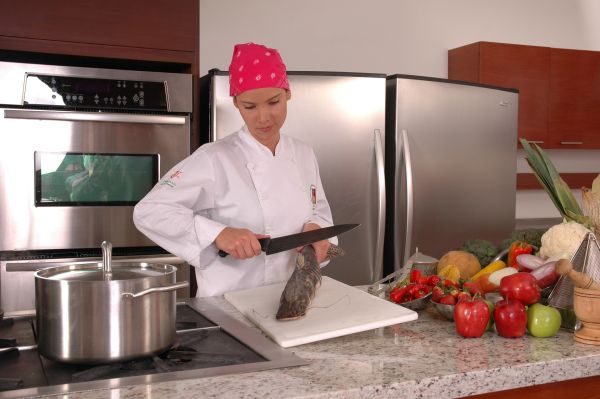
How to Explain SaaS Software to Your Grandma
Imagine you’re ready to optimize and automate a part of your business.
That part of your business is responsible for achieving a specific metric or outcome.
You know the ideal processes and workflows you need in place to simplify and streamline achieving that metric or outcome.
You want to limit human error, ensure data is being tracked and transferred properly so employees have easy access to what they need to move things forward, and avoid wasting employee time and easy money on inefficiency.

What software will you hire to work alongside you and your team?
To make it easy for you to explain the relative value of selecting Custom Software vs. Custom SaaS vs. Off-The-Shelf SaaS to your less tech-savvy colleagues, friends, and family, I’m going to use a food analogy.
Instead of software, imagine you’re buying a meal.
The same way software is really just data and workflows, a meal is just ingredients and a recipe.
You know the ingredients you like and the nutrients you need to increase your energy and output. You’re aware of your allergies, and want to limit your risk for disease and discomfort. You want to avoid wasting time and money on the inefficient processes and highly-specialized knowledge and cryptic communication of the person serving you.
Custom Software
- Ingredients start as seeds at the farm.
- You pay the price of an Executive Chef, even though your meal is mostly prepared by less experienced SouS Chefs.
- You don’t understand how the ingredients go from seed form to food form to meal form.
- It’s difficult to substitute ingredients or change your meal.
Custom Software would be like you asking for some cheese and an apple, and the restaurant (i.e. the custom development shop) telling you it’s going to take 12 months because they have to go plant the tree and milk the cow. Any food (i.e. feature or application) you need from a restaurant requires them to start from scratch on the farm growing, harvesting, and herding your food (i.e. build your software from source code).

You then pay for the Executive Chef (i.e. the seasoned software engineer who costs the big bucks) who has specialized (i.e. expensive) knowledge, even though he passes off the project to his less experienced Sous Chefs (i.e. the junior developers who just graduated from coding camp and ended up working on the software with which you are going to run your business).
When you ask for a different kind of cheese (i.e. a different feature, or for things to work another way), the price increases 30% as they reference the acidifying and fermentation process, which leaves you asking, “What’s acidifying and is fermentation a part of making cheese?”
You’re in the dark the whole time. You’re not a farmer or a software developer, you just want your apple and cheese (i.e. custom software solution) in a timely and cost-effective manner.
Custom SaaS
- Ingredients start as food at the grocery store.
- You partner with a Personal Chef to design your meal plan.
- The Personal Chef cooks your meals.
- It’s easy to understand how the food is combined into your meal.
- It’s easy to change your meal.
Custom SaaS is like going to the grocery story with a personal chef (i.e. Solutions Architect - see bottom of article for definition).
They get to know your current health status (i.e. where your metrics are relative to where you want them to be, the processes you use to run your company, and how clean and easy-to-access your data management is) and what your health goals are (i.e. your company growth plans and how the ideal version of your business would operate).
They use that insight to put a meal plan in place for you to achieve your health goals (i.e. a software road map of stacked sprints – see bottom for a definition). The first meals will address your most threatening health concerns (i.e. the processes that are the most damaging to your business’s productivity).

The meals are cooked by the personal chef to ensure they are delivered quickly and at the highest quality (i.e. I feel like you get this one).
The cost and complexity of the process go down because the ingredients are already ripe, prepared, and in food form (i.e. you’re customizing the data and workflows on a SaaS platform and don’t have to code something from scratch).
Your comfort goes up because you have a personal chef collaborating with you and cooking for you. You’re always in control because you can easily add ingredients as your dietary needs change – like when the newest Superfood comes out (i.e. you update your growth strategy to meet changing market conditions).
Off-The-Shelf SaaS = Microwaveable Meals
Off-the Shelf SaaS is the microwaveable meal. They are ideal for people who:
1. are willing to exchange their control for convenience and
2. believe the company providing the meal knows their dietary needs (i.e. business processes and software needs) better than they do.
The picture of the food on the box looks pretty appetizing (i.e. the software demo makes the product seem so powerful), but once you open the package you’re disappointed. Especially since the microwaveable meal only has a percentage of the nutrients (i.e. applications and features) you need. Thus, you end up looking for additional meals and meal-alternatives (i.e. other off-the-shelf applications, spreadsheets, or employees) to fill the gaps.
A widespread misconception is that microwaveable meals are more affordable than fresh, professionally prepared meals that are tailored to your dietary needs. That’s just not the case.
People believe this for two reasons:
1. They compare Off-The-Shelf SaaS prices with traditional Custom Software prices.
2. They don’t do a full cost-analysis to track how much they are spending on operational costs, additional work-arounds, and the mosaic of apps they’re leveraging to execute a process that can be done by a single Custom SaaS platform. Let alone, the opportunity costs...
In Conclusion
With budding conversations about AI, cryptocurrency, and quantum computing, it’s easy to be overwhelmed and feel out-of-touch with technology.
With everyone making old world/new world comparisons, it’s easy to be unsure if your next purchase will be considered “old world” in a year.
Focus on your business. Focus on the metrics you need to achieve. Focus on the people, processes, and communications you need to run your operations and grow your business.
Lead with strategy and find the software that will make executing that strategy simple.
“Growth creates complexity, and complexity is the silent killer of growth.” - Chris Zook, Founder’s Mentality
Your software should make managing your business simple, keep you agile so you can evolve and stay competitive, and empower you to spend your time and money on customer-pleasing, revenue-generating activity.
Next time you’re hungry to become the next best version of your business, consider a Custom SaaS platform – you won’t regret it.
Definitions:
A Solutions Architect is a data-minded, process professional who builds custom software solutions on a Custom SaaS platform, like OptimumHQ. They are not a full-fledged developer. They are experts in manipulating data and workflows to produce customized SaaS platforms that align with your business needs.
Stacked Sprints are a series of software projects that will make it easier for you to operate your business. A Stacked Sprint allows you to quickly receive – and only pay for – one software solution at a time which makes it easier to afford and ensures you’re solving productivity problems immediately. It’s the Custom SaaS version of a tiered offering. You literally build your way up from trial to premium to enterprise, with the ability to stop, pivot, or update at any time.
Watch the video that accompanies this blog and then Contact Us for a free consultation.